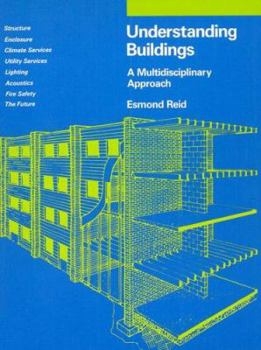Understanding Buildings: A Multidisciplinary Approach
Select Format
Select Condition 
Book Overview
Understanding Buildings provides students in architecture and other allied disciplines with a basic introduction to building technology in all its aspects. This general, multidisciplinary text provides an overall explanation of the building process through an examination of underlying principles as well as design examples. In seven chapters, the book discusses structure, enclosure, climate services, utility services, lighting, acoustics, fire safety,...
Format:Paperback
Language:English
ISBN:0262680548
ISBN13:9780262680547
Release Date:April 1988
Publisher:MIT Press
Length:230 Pages
Weight:1.10 lbs.
Dimensions:0.5" x 7.4" x 9.7"
Age Range:18 years and up
Grade Range:Postsecondary and higher
Customer Reviews
4 ratings
Suitable for the General Reading Public
Published by Thriftbooks.com User , 18 years ago
I am a fan of architecture with little technical background. I was drawn to this book because I wanted to increase my understanding of architecture by learning how the mechanical systems within buildings work. I began this endeavor with E. Allen's "How Buildings Work: The Natural Order of Architecture", perhaps the best introduction to the subject. Having enjoyed that book, I wanted to get to the next level of complexity. Esmond Reid's "Understanding Buildings" is an intermediate level book. The writing is at college freshman level and was easy to understand for a reader with no engineering or other technical background. The many line drawings helped immeasurably in getting across basic points. For the true beginner, I would recommend E. Allen's book. If you like that work, "Understanding Buildings" is an exciting progression in beginning to understand how the buildings we interact with on a daily basis work. Highly recommended.
Excellent Architectural And Engineering Primer
Published by Thriftbooks.com User , 19 years ago
This book was written mainly for aspiring architects and civil engineers, and covers almost all types of building systems thoroughly. It is very detailed and has separate chapters for important topics such as structure, climate services, lighting, acoustics, fire safety, etc. Although the author largely stays away from mathematics, he is always clear and concise in dealing even with complex analytical problems. As an example I would give his excellent treatment of two and three-hinged portals, and the fascinating parallels he draws between the engineering ideal of arches and the different types of portals. He covers all major construction techniques from timber platform frame construction (generally of houses), to more complex forms such as the hyperbolic paraboloid (opposed double curvature), and the esoteric "hyperboloid of revolution", the opposed double curvature architecture (almost always in concrete) common in power station cooling towers. His writing on accessory systems such as heating, air conditioning, ventilation, and fire detection and prevention are both introductory and comprehensive. In all areas from structure to systems he is careful to explain real-world rationale in an approachable format that is both thorough and easy to understand.This book is wonderful. It should be read by every student in engineering or architecture school (the section in chapter one on stresses is of enormous value to technical students), and I would further recommend it to practicing professionals as an excellent conceptual 'refresher course' of real world building systems wisdom. This is an excellent book.
Building construction and services deftly explained.
Published by Thriftbooks.com User , 21 years ago
It's rare to find an architect who can explain things in such a conversational way. The underlying principles are always laid out, first for a small building and then for a large one, to show the effects of changing scale. For example as the surface area to volume ratio changes, so do heating and cooling demands. And for me it was educational to see the British way of building houses: floor joists over concrete slabs, or brick basements. I learned the dew point drops gradually toward the exterior inside porous materials, and 15 deg east of south is the optimum solar orientation in the Northern hemisphere. And the slogan of the man who invented the revolving door ("It's always closed.") The second half of the book covers building services--heating, plumbing etc.--concisely, and it becomes apparent the author has plenty of real world experience and is no mere academic. Lighting, acoustics and fire safety finish the book. Even at 20 years old, still educational.
Clear, simple, complete coverage of building systems
Published by Thriftbooks.com User , 25 years ago
Mr. Reid presents each aspect of building development and construction simply and clearly while constantly highlighting their significance in the overall project development and construction process.The manner and tone of the material presented, as well as the text and illustrations make this book a valuable reference for people needing to grasp any or all aspects of building projects large, intermediate or small in scope and size.




